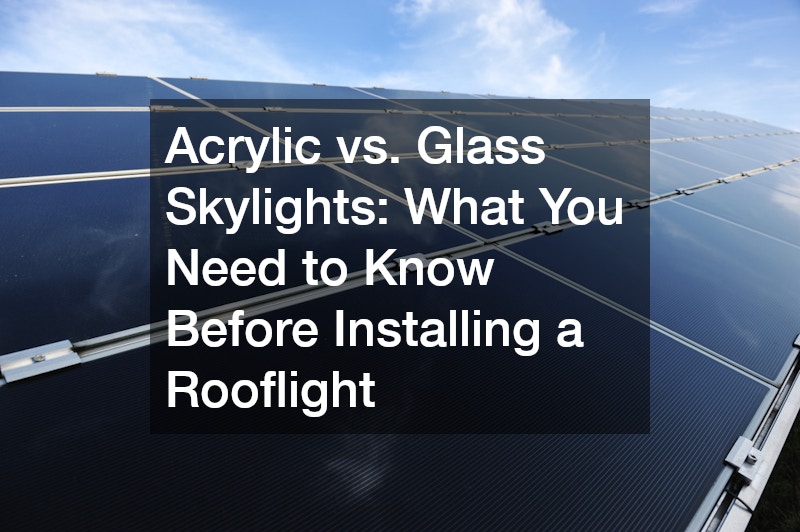Acrylic vs. Glass Skylights What You Need to Know Before Installing a Rooflight
When thinking about enhancing your home with a skylight, you’re likely considering factors such as natural light, aesthetics, and energy efficiency. However, one critical decision is often overlooked: the choice between acrylic and glass skylights. Each material comes with its own benefits and drawbacks, impacting not only the longevity of the skylight but also your home’s overall energy performance and even its compliance with building codes. If you’re on the market to buy rooflights, it’s essential to understand these key differences to make the best choice for your home.
The Longevity of Acrylic vs. Glass Skylights
One of the most important factors to consider when choosing between acrylic and glass skylights is durability. Skylights are exposed to constant weather changes, UV radiation, and temperature fluctuations, making their longevity a primary concern.
Acrylic skylights typically have a lifespan of about 10 to 15 years. Over time, exposure to sunlight can cause the acrylic material to degrade, leading to cracking. These cracks may eventually lead to leaks, allowing water to enter your home and causing potential damage to your interior. Once an acrylic skylight starts to crack, it will need to be replaced to prevent further issues.
On the other hand, glass skylights offer significantly better longevity. Similar to the glass used in car windows or the windows in your home, glass skylights can last for decades without any significant deterioration. Even after 20 years, a glass skylight can be as good as new, showing no signs of cracking or other wear. This makes glass a more reliable and long-term solution for those looking to buy rooflights that will stand the test of time.
Energy Efficiency: How Glass Skylights Outperform Acrylic
Energy efficiency is another crucial factor to consider when choosing a skylight. Your rooflight can either help or hinder your home’s ability to maintain a comfortable temperature, depending on the material you choose.
Glass skylights are coated with a special treatment called low-emissivity (low-E) coating. This coating significantly improves the skylight’s energy performance by reducing the amount of heat that passes through the glass. In colder months, the low-E coating prevents heat from escaping, helping to retain warmth inside your home and reducing the need for additional heating. Conversely, in warmer months, it blocks excess heat from entering your home, keeping the interior cooler and reducing the reliance on air conditioning.
Acrylic skylights, however, lack this energy-efficient coating. They allow heat to pass through more easily, meaning energy from heating or cooling systems can escape in winter or enter in summer. This can lead to increased energy costs over time, as your home will require more power to maintain a stable, comfortable temperature.
If you live in regions with extreme temperatures, especially areas with long, hot summers or cold winters, the energy savings offered by glass skylights make them a more practical investment. The higher initial cost of glass skylights is often offset by lower energy bills over time, making them the superior option for those looking to buy rooflights that are energy-efficient and environmentally friendly.
Building Code Compliance: Why Glass Skylights Meet Stricter Standards
For those living in states with stringent building codes, particularly California, choosing the right skylight is about more than just aesthetics and energy savings—it’s also about meeting local regulations. Glass skylights are often the only option that complies with both energy and fire safety codes.
In California, for instance, building regulations require that skylights meet certain energy efficiency standards. The low-E coating on glass skylights ensures they meet these criteria. Moreover, glass skylights are also more fire-resistant, making them compliant with fire safety regulations, which are especially important in areas prone to wildfires.
Acrylic skylights, on the other hand, generally do not meet these building code requirements. Their lack of a low-E coating means they fall short of the energy efficiency standards, and they also may not provide the same level of fire resistance as glass skylights. Therefore, if you’re looking to buy rooflights in California or any other area with strict building codes, glass skylights are often the only viable option.
The Cost Factor: Acrylic vs. Glass Skylights
It’s important to address the cost difference between acrylic and glass skylights. Acrylic skylights are generally less expensive upfront, which can be appealing for homeowners on a budget. However, their shorter lifespan and lack of energy efficiency may lead to higher long-term costs. You might find yourself needing to replace an acrylic skylight after a decade or so, and in the meantime, you may also incur higher energy bills due to their poor insulation properties.
Glass skylights, while more expensive initially, offer better long-term value. Their durability means you won’t need to replace them for decades, and their energy efficiency can lead to significant savings on heating and cooling costs over time. If you’re planning to buy rooflights that will serve your home well for years to come, glass skylights offer the best return on investment.
Conclusion: Choose Wisely When You Buy Rooflights
When it comes to installing skylights, choosing between acrylic and glass is not a decision to take lightly. Acrylic skylights may be a more affordable option upfront, but their shorter lifespan and lack of energy efficiency can lead to higher costs in the long run. Glass skylights, with their superior durability, energy-saving properties, and compliance with building codes, offer a more reliable and sustainable choice.
For homeowners looking to buy rooflights, glass skylights are the clear winner in terms of longevity, energy efficiency, and overall value. Whether you’re considering a skylight to brighten up a room, improve ventilation, or simply enhance your home’s design, investing in a high-quality glass skylight will ensure that your rooflight is an asset for years to come.
.

